7 Minutes
Introduction: A Concept That Bridged Past and Future
The MINI Concept Frankfurt unveiled at the 2005 Frankfurt Motor Show celebrated two anniversaries at once: 45 years since the original 1960 Mini Traveller and the modern MINI brand's rebirth in Frankfurt in 1997. Far from a pure retro exercise, the Concept Frankfurt was a forward-looking design study. It reinterpreted the Traveller's compact estate silhouette with contemporary engineering, inventive packaging and several practical innovations that foreshadowed later production models such as the Clubman.
Design Overview: Familiar MINI Traits, New Proportions
Exterior styling and packaging
From the front the Concept Frankfurt read unmistakably MINI thanks to the hexagonal grille, circular headlamps and short overhangs. But the proportions were radically different: a longer wheelbase, wider track and an elongated body gave it the appearance and utility of a true compact estate. The shoulder line rose gently toward the rear, creating a wedge-like profile that felt modern yet faithful to the original Traveller spirit. Muscular wheel arches, a pronounced powerdome bonnet and headlights integrated into a one-piece forward-hinged engine lid gave it an assertive, sports-car attitude.
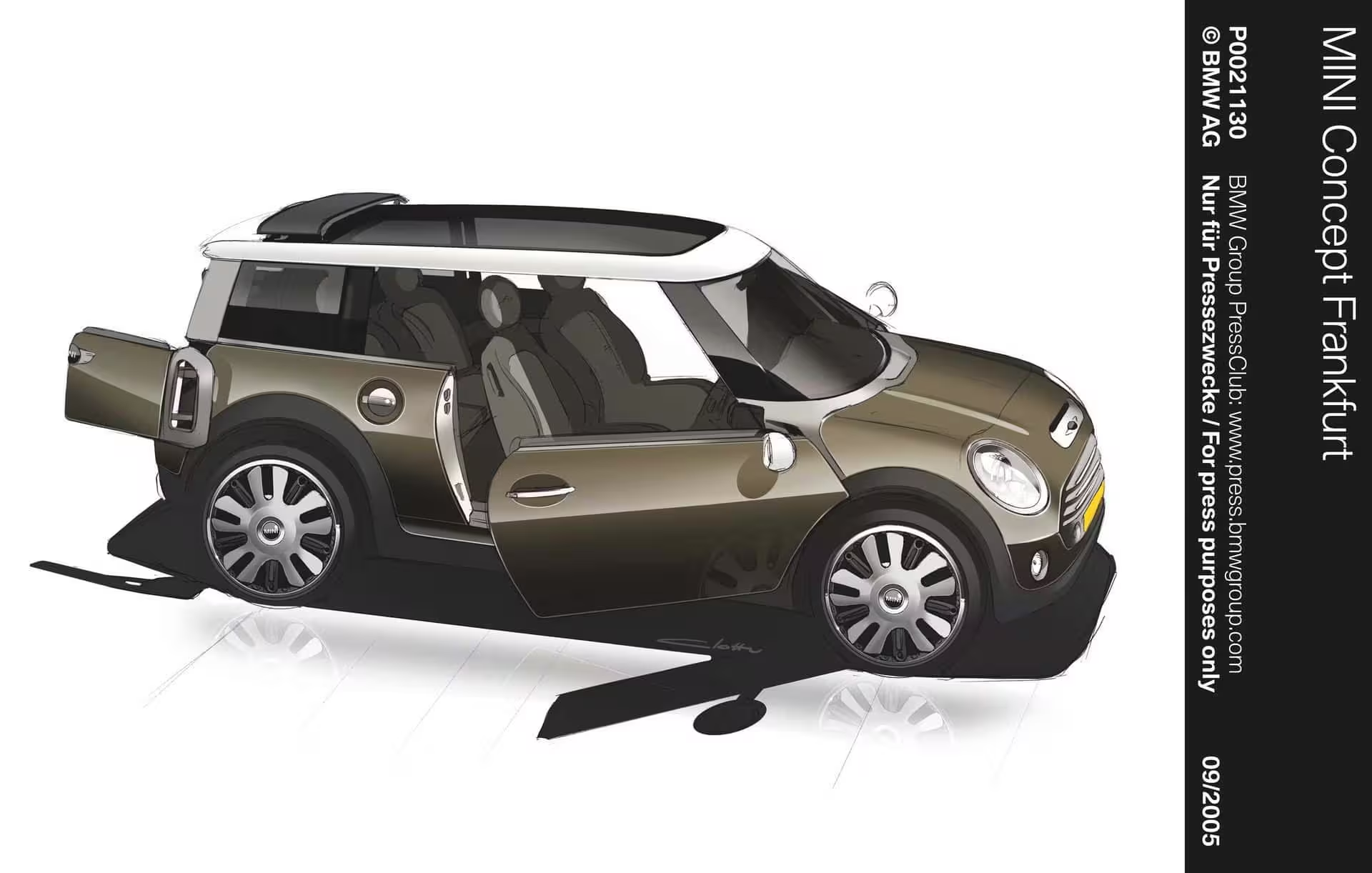
Materials, finishes and detailing
The concept wore a bespoke Satellite Silver paint applied in two subtly varied layers so the finish shifted from bright metallic to muted grey depending on the light. Black neoprene trim around the arches and lower body served both aesthetic and practical purposes, offering a tactile resilient surface for everyday use. Brushed aluminum C-pillars and grille accents were a deliberate nod to the Traveller’s heritage, while frameless glass and deletion of fixed B-pillars wrapped the cabin in uninterrupted glazing.
Access and Practicality: Rethinking Doors, Windows and Roof
All four side doors used parallelogram hinges, swinging outward and forward in a single motion to reduce opening footprint in tight spaces and make ingress and egress easier. The front coupe-style doors were unusually long, creating a broad side aperture when front and rear doors were open. Rear side windows referenced the Traveller's split panes: the front section electrically slid down beneath the rear section to create an almost convertible-like opening.
At the rear, a symmetrical side-hinged double-door arrangement made loading convenient from either side. A full-length glass roof ran from windscreen to tailgate, and the rear section of the roof could open upward completely to allow long items to be loaded from above.
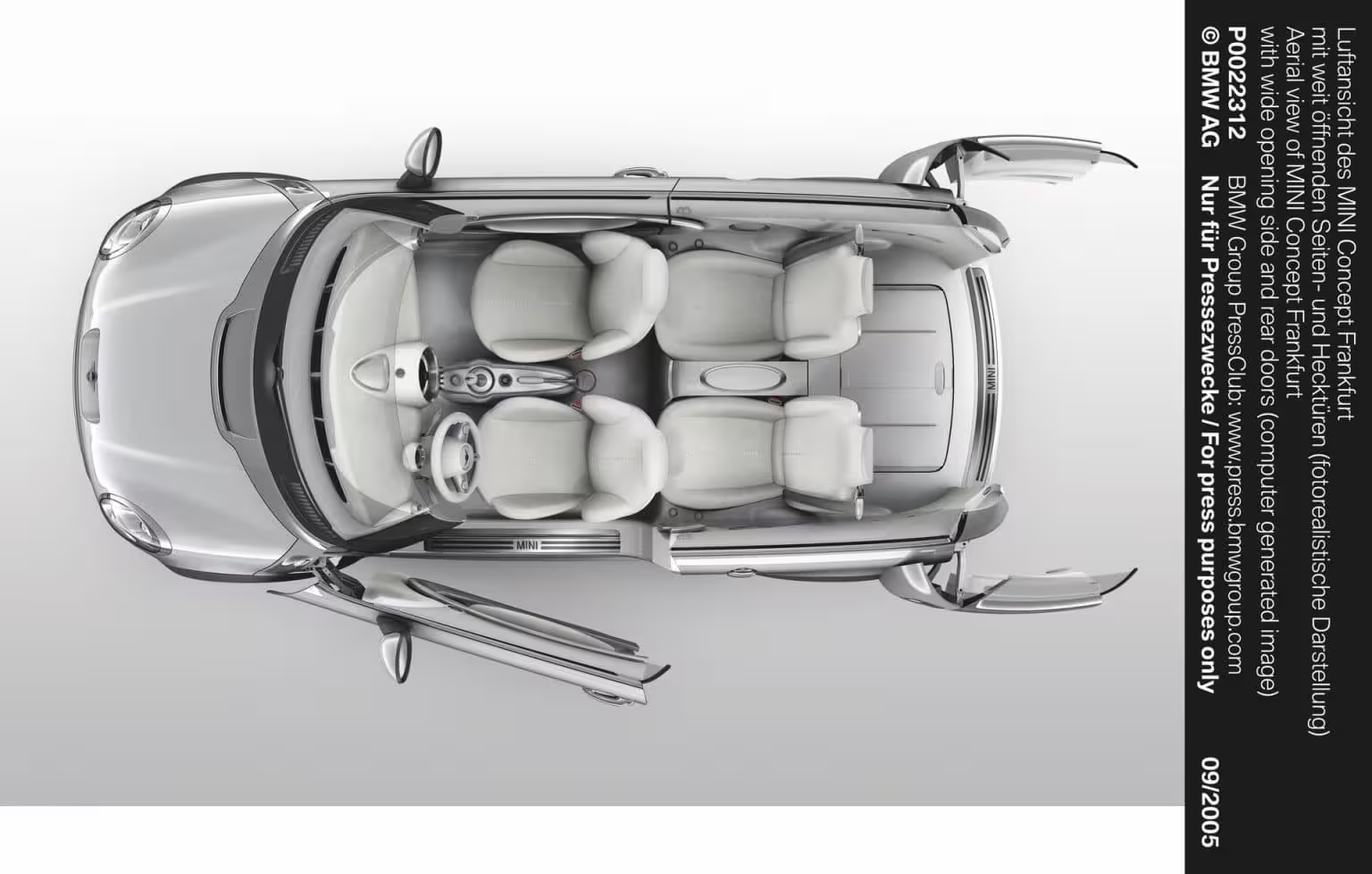
Cargo Innovations: The Cargobox and Modular Load Area
One of the Concept Frankfurt's standout practical features was the Cargobox, a sliding load floor that extended out of the boot for easy loading. The board also swivelled and could act as a partition between the passenger compartment and cargo space. Even with rear seats upright, the low load sill and generous aperture made daily use simple. Folding the split rear backrests produced a continuous flat load floor all the way to the dashboard, maximizing versatility for luggage, sports gear or small business use.
Other small but clever touches included frameless rear door windows to reach into the cargo area quickly, and chrome-ringed cupholders that folded out from side vents with climate-controlled drink temperature functionality.
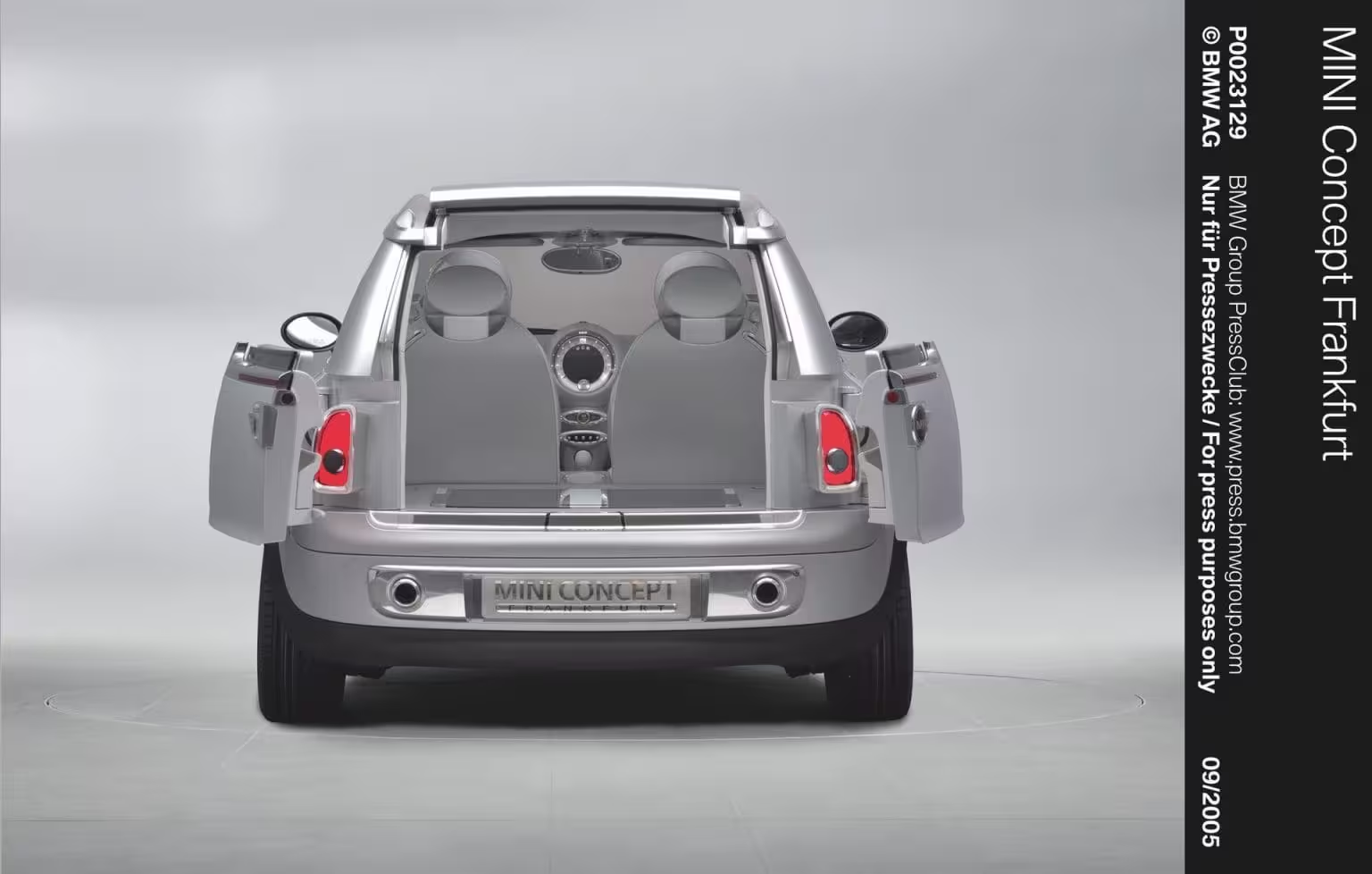
Interior and Ergonomics: Floating Seats and an Airy Cabin
The cabin extended MINI's circular design theme while amplifying the sense of space. Front seats were mounted to the central console rather than floor rails, creating a floating appearance and freeing up under-seat and rear footroom. An electric Easy-Entry system automatically moved the seats forward and rotated them inward for rear access, returning to driving position afterwards. Seatbelts were integrated into the seat frames themselves, removing the need for fixed B-pillars while maintaining occupant safety.
Material choices were premium and adventurous: white leather in multiple grains, brushed aluminium trims, chrome accent rings and glass-fibre weave panels. The headliner used Alcantara and the footwells sported a metallic carbon-look finish for a sporty, premium feel.
Performance and Mechanical Layout
Under the bonnet the Concept Frankfurt used the MINI Cooper S R53 power unit, the familiar 1.6 litre supercharged engine tuned to roughly 160–170 hp in period specification. The packaging of a longer wheelbase and wider track, with wheels pushed to the corners, was intended to preserve MINI’s trademark go-kart handling despite the larger estate body. Dual exhausts and an air intake scoop signalled the performance intent, while suspension geometry and weight distribution were adjusted to retain responsiveness in steering and cornering.
Specifications (Concept Highlights)
- Engine: MINI Cooper S R53 1.6L supercharged inline-4 (approx. 160–170 hp)
- Layout: Front-engine, front-wheel drive
- Wheelbase: Longer than contemporary MINI hatchback (concept lengthened for estate packaging)
- Track: Wider front and rear for improved stability
- Doors: Four side doors with parallelogram hinges, frameless glazing
- Roof: Full-length glass roof with opening rear section
- Cargo: Sliding 'Cargobox' load floor and fold-flat rear seats
Note: As a concept car, exact production-spec dimensions and weights were not finalized.
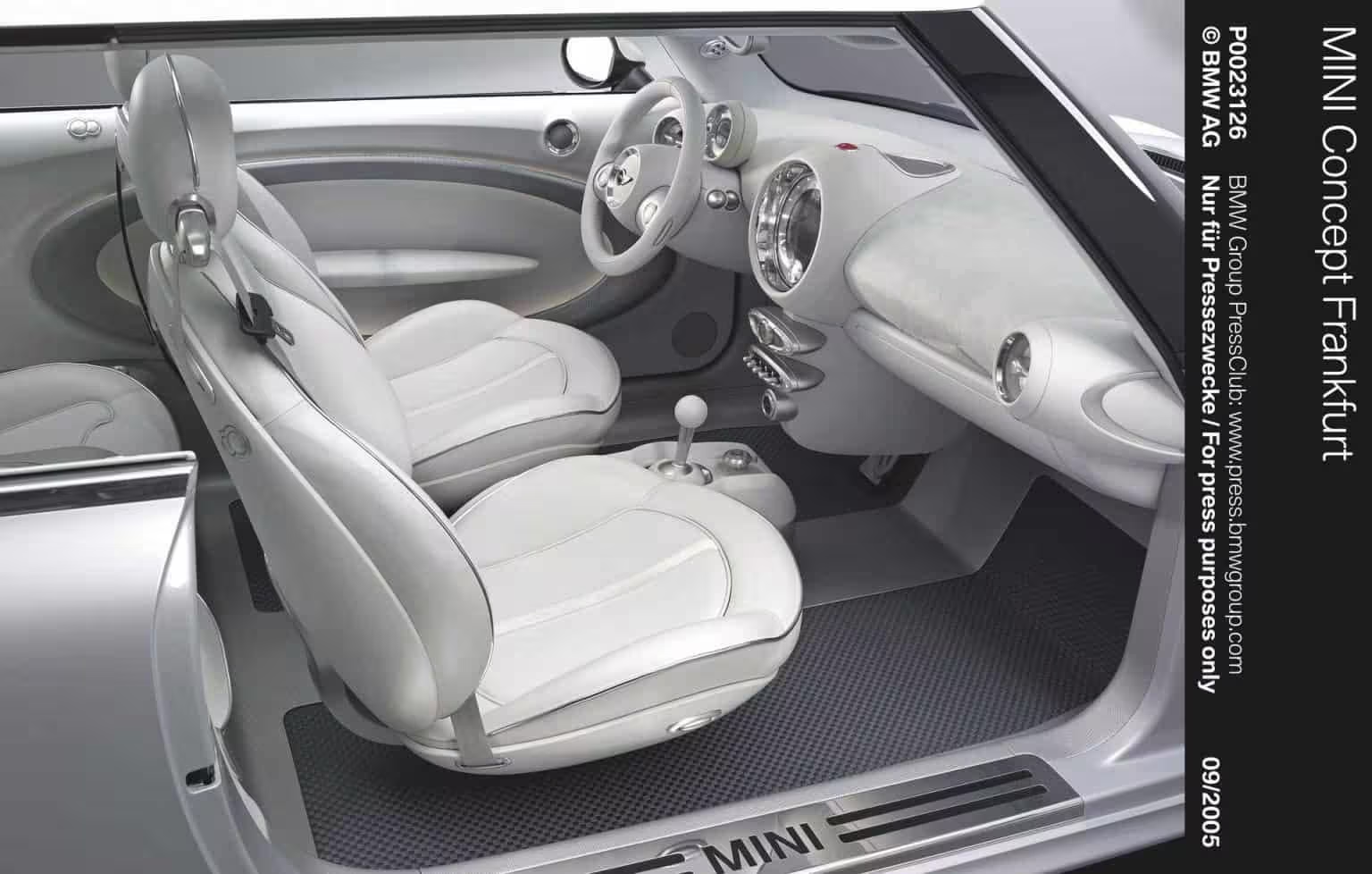
Market Positioning and Legacy
Although the Concept Frankfurt never entered series production in its show form, it acted as a strategic showcase for how MINI could expand beyond the three- and five-door hatchback segments to a compact, premium estate offering. Many of the concept’s functional ideas and styling cues later appeared in production MINIs, most notably the Clubman. The Concept Frankfurt reinforced MINI’s position as a small premium brand that balances iconic styling with clever packaging and practical everyday usability.
Comparisons: Concept Frankfurt vs Production Clubman
The Clubman adopted the idea of a compact estate with split rear doors and enhanced versatility, but the Concept Frankfurt was bolder: frameless glazing, longer coupe-like doors with no B-pillars, full-length glass roof and the Cargobox were largely exclusive to the concept. In performance terms the Clubman used contemporary MINI powertrains and more conventional body engineering for production constraints, while the Concept Frankfurt demonstrated what could be possible when packaging and creativity were prioritized over cost and serviceability.
Conclusion: A Thoughtful, Influential Design Study
The MINI Concept Frankfurt was more than nostalgia; it was a functional exploration of how a small car could be reimagined for modern life. By combining strong design references to the Traveller with inventive access solutions, modular cargo ideas and a performance-minded chassis, MINI demonstrated that a compact estate could be both characterful and genuinely usable. For enthusiasts and designers alike, the Concept Frankfurt remains a notable example of a motor show concept that had real influence on future production models.
Source: bmwblog

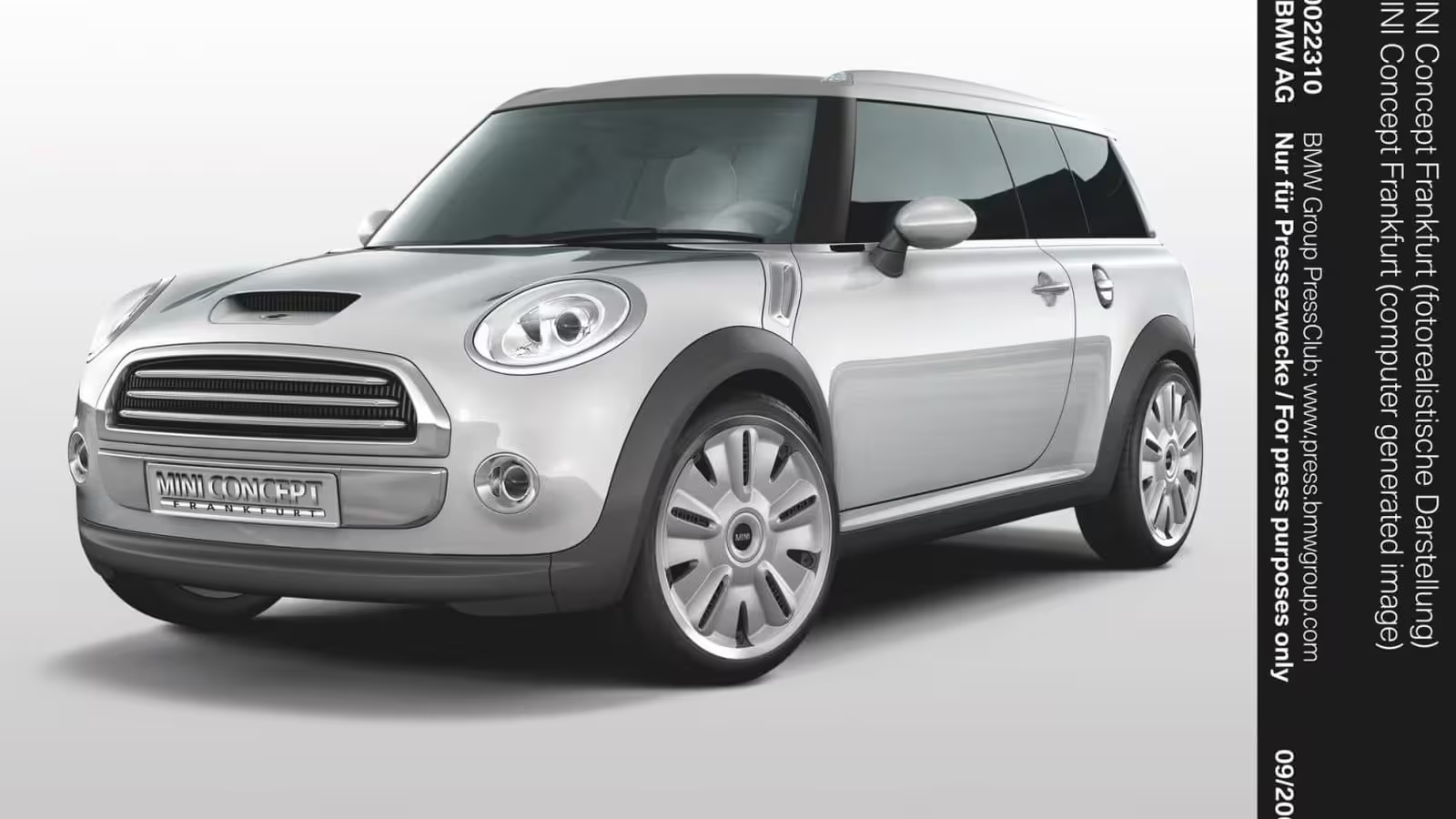
Leave a Comment